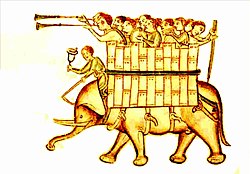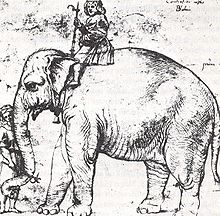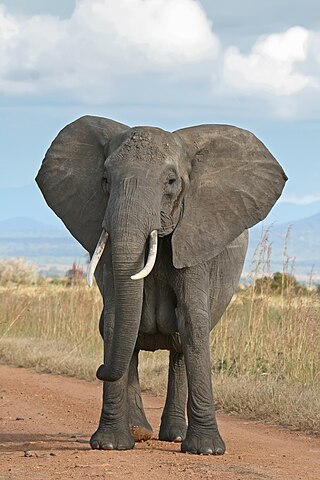
Elephants are the largest living land animals. Three living species are currently recognised: the African bush elephant, the African forest elephant, and the Asian elephant. They are the only surviving members of the family Elephantidae and the order Proboscidea; extinct relatives include mammoths and mastodons. Distinctive features of elephants include a long proboscis called a trunk, tusks, large ear flaps, pillar-like legs, and tough but sensitive grey skin. The trunk is prehensile, bringing food and water to the mouth and grasping objects. Tusks, which are derived from the incisor teeth, serve both as weapons and as tools for moving objects and digging. The large ear flaps assist in maintaining a constant body temperature as well as in communication. African elephants have larger ears and concave backs, whereas Asian elephants have smaller ears and convex or level backs.

The African forest elephant is one of the two living species of African elephant. It is native to humid tropical forests in West Africa and the Congo Basin. It is the smallest of the three living elephant species, reaching a shoulder height of 2.4 m. As with other African elephants, both sexes have straight, down-pointing tusks, which begin to grow once the animals reach 1–3 years old. The forest elephant lives in highly sociable family groups of up to 20 individuals. Since they forage primarily on leaves, seeds, fruit, and tree bark, they have often been referred to as the 'megagardener of the forest'; the species is one of many that contributes significantly to maintaining the composition, diversity and structure of the Guinean Forests of West Africa and the Congolese rainforests. Seeds of various plants will go through the elephant’s digestive tract and eventually pass through in the animal’s droppings, thus helping to maintain the spread and biodiversity of the forests.
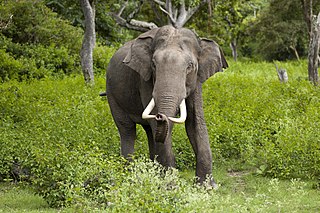
The Asian elephant, also known as the Asiatic elephant, is the only living species of the genus Elephas and is distributed throughout the Indian subcontinent and Southeast Asia, from India in the west, Nepal in the north, Sumatra in the south, and to Borneo in the east. Three subspecies are recognised—E. m. maximus from Sri Lanka, E. m. indicus from mainland Asia and E. m. sumatranus from the island of Sumatra. Formerly, there was also the Syrian elephant or Western Asiatic elephant which was the westernmost population of the Asian elephant. This subspecies became extinct in ancient times. Skeletal remains of E. m. asurus have been recorded from the Middle East: Iran, Iraq, Syria, and Turkey from periods dating between at least 1800 BC and likely 700 BC. It is one of only three living species of elephants or elephantids anywhere in the world, the others being the African bush elephant and African forest elephant. It is the second largest species of elephant after the African bush elephant.

The Association of Zoos and Aquariums (AZA), originally the American Association of Zoological Parks and Aquariums, is an American 501(c)(3) nonprofit organization founded in 1924 and dedicated to the advancement of zoos and public aquariums in the areas of conservation, education, science, and recreation. AZA is headquartered in Silver Spring, Maryland, and accredits zoos. There were 238 accredited facilities as of 2019, primarily in the US, and also a handful in eleven other countries.

The African buffalo is a large sub-Saharan African bovine. There are five subspecies that are recognized as being valid. Syncerus caffer caffer, the Cape buffalo, is the nominotypical subspecies, and the largest one, found in Southern and East Africa. S. c. nanus is the smallest subspecies, common in forest areas of Central and West Africa, while S. c. brachyceros is in West Africa and S. c. aequinoctialis is in the savannas of East Africa. The adult African buffalo's horns are its characteristic feature: they have fused bases, forming a continuous bone shield across the top of the head referred to as a "boss".

Musth or must is a periodic condition in bull (male) elephants characterized by aggressive behavior and accompanied by a large rise in reproductive hormones.

The Oakland Zoo is a zoo located in the Grass Valley neighborhood of Oakland, California, United States. Established on June 6, 1922, it is managed by the Conservation Society of California, a 501(c)(3) non-profit organization dedicated to the conservation of wildlife both locally and globally. The zoo is home to more than 850 native and exotic animals and is a member of the Association of Zoos and Aquariums (AZA).

Chester Zoo is a zoo at Upton-by-Chester, Cheshire, England. Chester Zoo was opened in 1931 by George Mottershead and his family. It is one of the UK's largest zoos at 51 hectares. The zoo has a total land holding of approximately 160 hectares.

African elephants are members of the genus Loxodonta comprising two living elephant species, the African bush elephant and the smaller African forest elephant. Both are social herbivores with grey skin, but differ in the size and colour of their tusks and in the shape and size of their ears and skulls.
Elephant crushing, or a training crush, is a method by which wild elephants can be tamed for domestication, using restriction in a cage, sometimes with the use of corporal punishment or negative reinforcement. This practice is condemned by a variety of animal-welfare groups as a form of animal cruelty.

Captive breeding, also known as captive propagation, is the process of keeping plants or animals in controlled environments, such as wildlife reserves, zoos, botanic gardens, and other conservation facilities. It is sometimes employed to help species that are being threatened by the effects of human activities such as climate change, habitat loss, fragmentation, overhunting or fishing, pollution, predation, disease, and parasitism.

Animal captivity is the confinement of domestic and wild animals. More specifically, animals that are held by humans and prevented from escaping are said to be in captivity. The term animal captivity is usually applied to wild animals that are held in confinement, but this term may also be used generally to describe the keeping of domesticated animals such as livestock or pets. This may include, for example, animals in farms, private homes, zoos, and laboratories. Animal captivity may be categorized according to the particular motives, objectives, and conditions of the confinement.

Behavioral enrichment is an animal husbandry principle that seeks to enhance the quality of captive animal care by identifying and providing the environmental stimuli necessary for optimal psychological and physiological well-being. Enrichment can either be active or passive, depending on whether it requires direct contact between the animal and the enrichment. A variety of enrichment techniques are used to create desired outcomes similar to an animal's individual and species' history. Each of the techniques used is intended to stimulate the animal's senses similarly to how they would be activated in the wild. Provided enrichment may be seen in the form of auditory, olfactory, habitat factors, food, research projects, training, and objects.

Woburn Safari Park is a safari park located in Woburn, Bedfordshire, England. Visitors to the park can drive through exhibits, which contain species such as southern white rhino, elephants, tigers and black bears. It is part of the estates of the Duke of Bedford that also includes Woburn Abbey and its 3,000-acre (1,200 ha) deer park. The Safari Park itself covers 360 acres (150 ha).
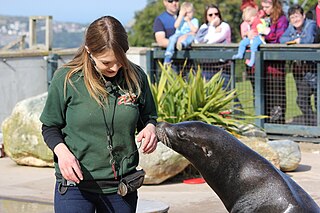
A zoo is a facility in which animals are kept within enclosures for public exhibition and often bred for conservation purposes.

Pinnawala Elephant Orphanage, is a captive breeding and conservation institute for wild Asian elephants located at Pinnawala village, 13 km (8.1 mi) northeast of Kegalle town in Sabaragamuwa Province of Sri Lanka. Pinnawala has the largest herd of captive elephants in the world. In 2023, there were 71 elephants, including 30 males and 41 females from 3 generations, living in Pinnawala.

The African bush elephant, also known as the African savanna elephant, is one of two extant African elephant species and one of three extant elephant species. It is the largest living terrestrial animal, with bulls reaching a shoulder height of up to 3.96 m and a body mass of up to 10.4 t.
Elephant endotheliotropic herpesviruses (EEHV) or Elephantid betaherpesvirus 1 (ElHV-1) is a type of herpesvirus, which can cause a highly fatal hemorrhagic disease when transmitted to young Asian elephants. In African elephants, related forms of these viruses, which have been identified in wild populations, are generally benign, occasionally surfacing to cause small growths or lesions. However, some types of EEHV can cause a highly fatal disease in Asian elephants, which kills up to 80% of severely affected individuals. The disease can be treated with the rapid application of antiviral drugs, but this has only been effective in around a third of cases.

Elephants communicate with each other in various ways, including touching, visual displays, vocalisations, seismic vibrations, and semiochemicals.
Thomas B. Hildebrandt is a German veterinarian researcher dedicated to species conservation. He heads the Department of Reproduction Management at the Leibniz Institute for Zoo and Wildlife Research (IZW) in Berlin and holds a full professorship for Wildlife Reproduction Medicine at the veterinary faculty of the Freie Universität Berlin.


